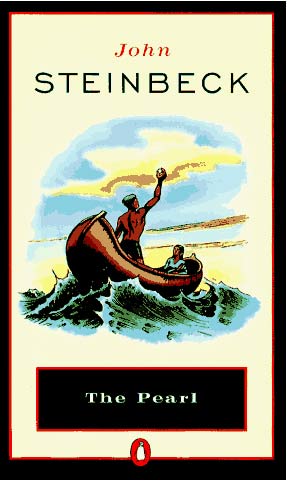|
THE PEARL by John Steinbeck
Steinbeck wrote The Pearl based on his personal convictions, and based the story on the biblical parable of a ‘pearl of great price.' In this story, a jewel for which the merchant trades everything he owns becomes the metaphor for Heaven. Everything in the merchant's earthly existence, however, becomes worthless when compared to the joys of living with God in Heaven. However, Steinbeck uses the parable as a meditation on the American dream of success. Steinbeck, who himself had risen quickly to prosperity, explores how Kino, the protagonist of The Pearl, deals with his newfound prominence in the community and riches. Steinbeck found a second inspiration for The Pearl in the tale of a young Mexican boy told in Steinbeck's Sea of Cortez. However, the boy in the original form of the story wished to use the pearl to buy clothing, alcohol and sex. The story contains several similar plot points, including the rapacious dealers and the attacks on the boy to find the pearl, that would recur in the story's final form. The Pearl derives much of its force from the descriptions of the impoverished lifestyle of the Mexicans of La Paz, the location of the story. The plight of the impoverished is a consistent theme in Steinbeck's work, including The Grapes of Wrath and Of Mice and Men. Although these novels dealt with white protagonists, Steinbeck turned to the plight of Mexicans for The Pearl based on the 1942 and 1943 Zoot Suit Race Riots in Los Angeles. By the time that Steinbeck wrote The Pearl, he had gained an interest in writing screenplays, and thus wrote the novel in a form suitable for easy adaptation to film. The story has a simple plot structure and an economy of characters, but unlike The Grapes of Wrath, Of Mice and Men, and East of Eden, Steinbeck did not adapt The Pearl. Instead, Steinbeck focused on screenplays written originally for the screen for his subsequent works. Source: http://www.gradesaver.com/ClassicNotes/Titles/pearl/about.html
|
|||
 John Steinbeck wrote The Pearl during the time in which he was at the height of his fame. He had completed The Grapes of Wrath, for which he won the Pulitzer Prize for fiction and was renowned and reviled as a subversive, unpatriotic man who threatened the national interest through the socialist themes of his novels. This view of Steinbeck was inconsistent with his soft-spoken nature, but by 1944, when Steinbeck began to write The Pearl, Steinbeck had come to reconcile this aspect of his fame.
John Steinbeck wrote The Pearl during the time in which he was at the height of his fame. He had completed The Grapes of Wrath, for which he won the Pulitzer Prize for fiction and was renowned and reviled as a subversive, unpatriotic man who threatened the national interest through the socialist themes of his novels. This view of Steinbeck was inconsistent with his soft-spoken nature, but by 1944, when Steinbeck began to write The Pearl, Steinbeck had come to reconcile this aspect of his fame.